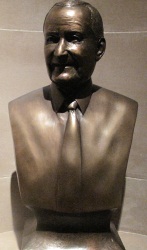Frank Lewis O’Bannon was born on January 30, 1930 in Louisville, Kentucky and was raised by his parents, along with four siblings, in Corydon, Indiana. O’Bannon’s family was active in politics, which was a legacy that he would carry on. His grandfather, Lew M. O’Bannon was a local politician, and ran as the Democratic candidate for Lieutenant Governor in 1924. In 1907, Lew purchased the Corydon Democrat, a newspaper which would become a family-run business. O’Bannon’s father, Robert P. O’Bannon, served in the State Senate for 26, until he was replaced by Frank O’Bannon in 1969.34
Frank O’Bannon attended school in Corydon, graduating from Corydon High School in 1948 as the class president. He then earned a degree in government from Indiana University in 1952, after which he served for two years in the Air Force. After leaving the military, O’Bannon earned a law degree at IU, opening a private practice in Corydon in 1957. While he worked as a lawyer, O’Bannon maintained his connections to the family newspaper, working as a journalist and photographer. It was at this time that Frank O’Bannon married Judy Asmus.35
In 1970, when O’Bannon’s father was retiring from the State Senate, Frank O’Bannon decided to run for his father’s Senate seat. He was successful in that endeavor, and would go on to serve for 18 years as a State Senator representing Corydon. In that time, he served as Senate Finance Chairman for two years and Democratic Floor Leader for 11 years. Throughout that time, O’Bannon continued to serve as the chairman of the O’Bannon Publishing Co.36
As he served in multiple leadership positions in the State Senate, O’Bannon gained a lot of recognition for his bipartisan approach, and he became a leader in Indiana’s Democratic Party. Many within the party were hoping that O’Bannon would run for a statewide office, and as the 1988 gubernatorial election approached, O’Bannon’s name was mentioned frequently. At the same time, Evan Bayh, the son of Indiana’s former Senator Birch Bayh, was making it clear that he intended to run for governor. As Bayh’s campaign gained momentum, O’Bannon stepped aside and agreed to run on the Democratic ticket as the candidate for lieutenant governor.37 After running a successful campaign, O’Bannon served Indiana for eight years in that office. His years as president of the Senate brought O’Bannon’s total time of service in the Indiana Senate to 26 years.
In 1996, O’Bannon was unopposed for the Democratic nomination for Governor, choosing Joseph E. Kernan as his running mate. The two ran a successful campaign that year, and again four years later to win the election for a second term. Throughout his time in the highest executive office in Indiana, O’Bannon focused his efforts on children and education. His two inaugurations gained him much attention, as he invited fourth graders from around the state to attend. His 1997 inauguration was the first outdoor inauguration since 1933, and it was attended by thousands of fourth graders. Four years later, the inauguration was held at the RCA Dome, and it was attended by 25,000 fourth graders.38
In the course of his eight years as Governor, O’Bannon faced varying financial situations. In 1997, Indiana had a surplus of funds, but a recession over the following years which caused a downturn in Indiana’s economy. This situation made it difficult for O’Bannon to win support for his legislation which called for the funding of full-day kindergarten. O’Bannon also became known for suspending Indiana’s 5% sales tax on gasoline in the summer of 2000 when prices soared. As the state continued to face financial problems, the General Assembly held a special session in which they passed tax increases and restructured the tax system.39
In the fall of 2003, Governor O’Bannon had introduced a new initiative, “Energize Indiana,” which he hoped would bring technological corporations to Indiana to boost the economy and create jobs. He planned a statewide tour to publicize his plan. That September, O’Bannon was attending a trade conference in Chicago when he suffered a stroke. Five days afterward, he passed away at Northwestern Memorial Hospital in that city. It was the fourth time in Indiana’s history that a governor had died in office.40 Following O’Bannon’s death, a memorial was set up at the Indiana State House, constructed of three wooden panels that were covered in photographs of the late governor. An official portrait of the governor was flanked by two state police officers, and thousands of Hoosiers and others travelled to the State House to pay their respects.41 O’Bannon’s body was cremated, and the ashes have been interred at Cedar Hill Cemetery in Corydon. A statue commemorates O’Bannon at the Old Courthouse Square in Corydon.42
Bust History
Following O’Bannon’s death, the Indiana General Assembly formed the “Commission to Recommend a State House Memorial for Governor O’Bannon.” State Senator James Merritt and Representative Paul Robertson co-chaired the commission. Their first meeting was held on June 16, 2004. At this meeting, they discussed their charge “to make recommendations for the creation of a suitable memorial for the Statehouse to honor the memory of the late Governor Frank O’Bannon.” The members of the commission had already discussed their desire to have a bust of O’Bannon produced, with the intention of placing it in the niche outside of the south door to the Senate chamber. At that time, the niche was occupied by the bust of Calvin Fletcher (which was moved to the fourth floor). During that first meeting, comparisons to the bust of Robert Orr, Sherman Minton and Richard Owen were made, and the commission members had wanted the bust to be similar in size as that of Robert Orr. This bust was/is located in the niche outside of the north door to the Senate chambers.43
During the first meeting of the commission, six artists were interviewed, including Kenneth G. Ryden. He brought along a folder which included a letter to the commission, a photograph of himself with Gov. O’Bannon, information and photographs of other works that he had completed, a short biography, Ryden’s business card and a brochure for Ryden Galleries. Ultimately, Ryden was chosen from among the six candidates to receive the commission. The completed bust was unveiled in its location in the Statehouse on February 13, 2006. The sculptor dedicated the bust to O’Bannon’s family.44
Sculptor
Kenneth G. Ryden
Kenneth G. Ryden was born in Chicago, Illinois and currently lives in Yorktown, Indiana. He works primarily in bronze, and has created a number of memorial works including pieces which honor Carl Erskine and Martin Luther King, Jr. When Ryden received the commission for the O’Bannon bust, he was the artist-in-residence at Anderson University.45
34 Stemle, Cary G. “Frank L. O’Bannon” in Governors of Indiana. Indianapolis: Indiana Historical Society Press, 2006. p 384-385.
35 Ibid. p 386.
36 “Frank O’Bannon.” Governor Daniels - Previous Governors. 2011. http://www.in.gov/gov/2344.htm.
37 Stemle, Cary G. p 386-387.
38 Ibid. p 388-389.
39 Ibid. p 389-391.
40 “Governor O’Bannon has died.” 13 WTHR Indianapolis. http://wthr.com/story/1441436/governor-obanon-has-died.
41 Davey, Monica. “Letter from Indianapolis; with respect, a state pauses (even its politicians).” The New York Times. September 21, 2003.
42 “Frank Lewis O’Bannon (1930-2003).” The Political Graveyard.
43 “Commission to Recommend a State House Memorial for Governor O’Bannon Meeting Minutes.” June 16, 2004. Indianapolis: Legislative Services Agency, 2004.
44 “Frank O’Bannon (bust).” http://en.wikipedia.org/wiki/Frank_O%27Bannon_Memorial_%28bust%29.
45 Ibid.

